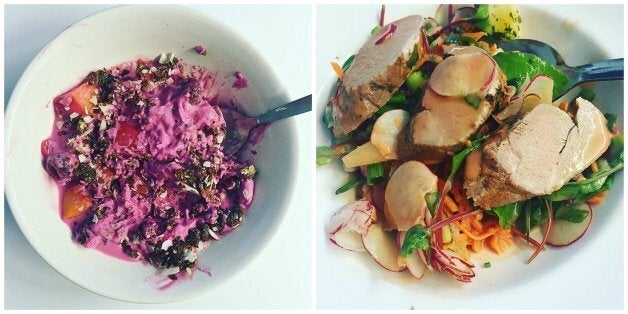
I eat porridge with berries for breakfast, a bagel with cream cheese for lunch and some sort of stir fry for dinner. Add in a few biscuits, coffees and a banana and that's it. Every single day.
A creature of habit, I'd slowly become tired and uninspired by trying anything new because a) I didn't have the time and b) I didn't have the motivation to branch out and buy something different.
So, in a bid to shake things up a little, I decided to try Soulmate Food, a meal delivery service that offers nutritious and innovative food (at least, that was the claim).
After a few days, I realised how little I knew about the food I normally put in my mouth and how much I was missing out on by sticking the same go-to food in my shopping basket.
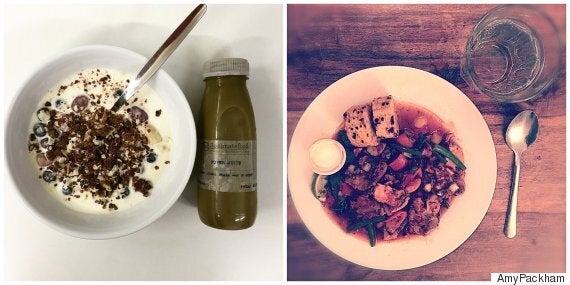
A selection of Soulmate Food delivery: Zesty orange yoghurt, fruit and granola (L), Chipotle chicken with charred corn on the cob (R)
I opted for the maintenance plan.
"As the name suggests, the plan is designed around maintenance of weight, not a change in body composition," Christian Coates, nutritionist and CEO of Soulmate explained.
"It's aimed a people who are happy with their weight and are looking to eat interesting and healthy meals. The daily intake is provided to match daily energy expenditure to maintain weight."

The food came packaged in plastic containers with labels detailing the ingredients and when it should be eaten
Because the food is fresh, you get two deliveries throughout the six days. The menu will tell you what you eat for breakfast, lunch and dinner as well as giving you snacks.
I learned four very valuable lessons about food during those six days.
1) Trying new foods will always pay off
When I received the menu for the first three days, I was embarrassed I hadn't actually tried (or heard of) some things on the menu.
I had never heard or eaten baba ganoush, Za'atar or tabbouleh - all Middle Eastern delights.
It was also probably quite shocking I'd never eaten a frittata, tagine and rarely beetroot. Oops.
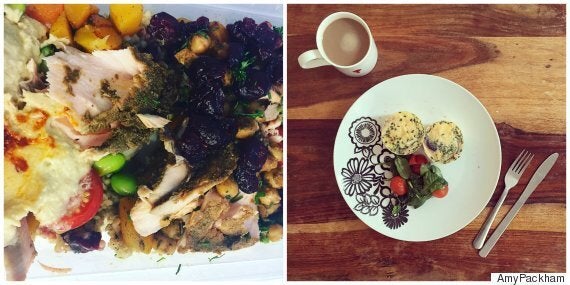
LEFT: Za'tar salmon with cranberry tabbouleh. RIGHT: Hash brown frittata and salad
We grow up with our parents constantly telling us to try new foods but the older we get, the less we are forced into variety. Before starting the food plan, I don't remember the last time I tried something new.
I was open-minded and it paid off. Tabbouleh is delicious (something I have bought since trying out the plan) and I learned a frittata breakfast was a great alternative to cereal on the weekend.
"Trying new foods means that your expanding the variance of foods in your diet," said Coates. "Each food has specific nutritional properties with some being higher in certain vitamins and mineral and potentially lacking in others.
"By eating a wide variety of different foods and food groups, you will be ensuring that you are not missing out on vital vitamins and minerals. By limiting yourself to certain foods the risk of deficiency is quite high."
2) Experimenting with combinations makes food so exciting
The biggest lesson I learned was about how to combine food for vibrant and interesting flavours.
Almost every dinner in the plan included fruit: cranberries with salmon and houmous, pork with pineapple, blood orange dressing with chicken and coconut with tomatoes.
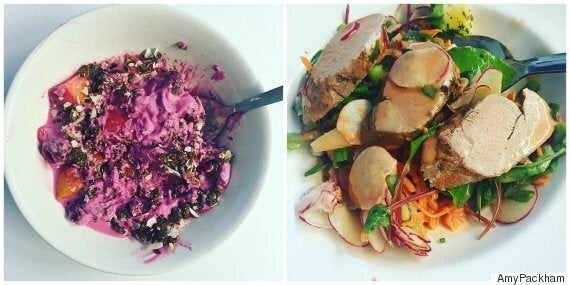
Beetroot, raspberry and lemon yoghurt with granola (L), Honey pork with pineapple salsa and blood orange dressing
I like fruit, I like meat and I like vegetables - but I've never thought of putting them together.
However, while gobbling down the most delicious lunch of the whole plan (salmon, tabbouleh, cranberries, edamame beans and houmous), I realised adding fruit to these savoury meals brought out so much more flavour.
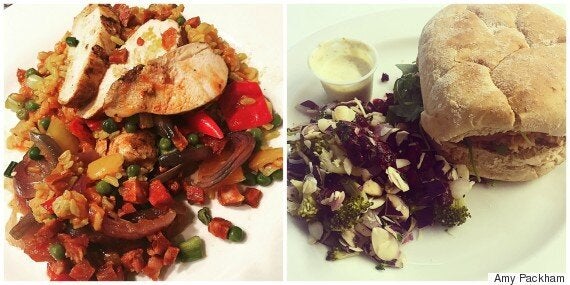
Paella with paprika chicken, caramelised onion and currants (L), BBQ pulled pork with cranberry and broccoli slaw (R)
It made the food so much more interesting.
"Adding fruit to savoury meals helps us improve flavour without the use of refined sugars," Coates explained. "It also gives the dish a big nutritional boost."
He was right. The dinners filled me up, yet they weren't heavy or full of carbs like my usual meals. They were light, fresh and filling.
3) Snacking isn't a bad thing
We're brought up to believe we eat three times a day and snacking is there to take the edge of pre-meal time hunger.
But with this plan, snacking was incorporated into my daily diet without me feeling guilty about it. The plan involved a morning snack before lunch and an afternoon one before dinner.
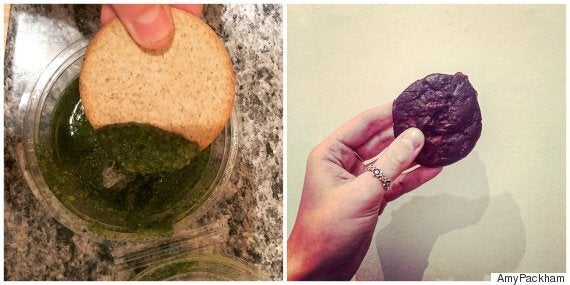
Cashew and parsley spread with oatcakes (L), avocado chocolate cookie (R)
Initially I found myself thinking I wasn't even hungry when I realised it was snack time, but by the end of the six days, eating little and often helped me avoid that mid-afternoon slump at work.
In fact, Coates told me eating more can help control hunger levels and in turn, potentially reduce bingeing on bad food choices when you get hungry.
Some of the best snacks were foods I had rarely eaten before: pitta and red pepper baba ganoush, sesame chicken bites, berry pots, avocado cookies and something I didn't think I'd enjoy but genuinely did: mixed nuts.
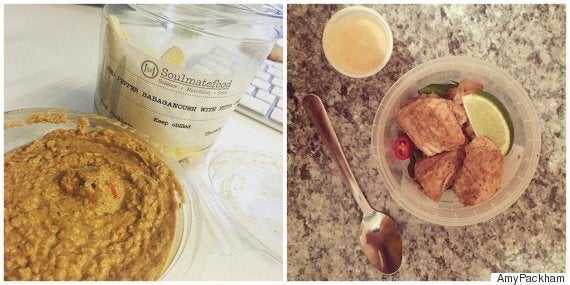
Red pepper baba ganoush with pitta chips (L), Jerk chicken bits with dressing (R)
"Snacking shouldn't be discouraged," Coates reassured. "When we think of snacking we think of crisps/chocolate/biscuits, this is where the idea of snacking being bad came from.
"However, from a muscle building or muscle preservation perspective, frequent servings of protein five times per day, every three hours has been shown by research to be the most effective means by which to do build or preserve muscle mass."
Coates said although snacking on it's own doesn't boost metabolism, it can indirectly help.
He said: "This is due to snacking on high protein snacks (such as chicken breast, beef jerky, nuts, greek yoghurt, a glass of milk) helping maintain/build muscle mass, and the more muscle mass you have, the higher your metabolism will be."
4) Including all food groups in your diet is essential
What I hadn't realised about my repetition of eating the same foods each day prior to doing this plan, was that it was actually bad for me. The food I was eating wasn't bad, but I didn't have a varied diet.
"People don't always understand the importance of consuming a varied diet, to improve health and vitality whilst maintaining weight," Coates said.
"Ideally, you should never cut out any full food group and avoid they hype around unfounded intolerances and free-from foods without medical advice."
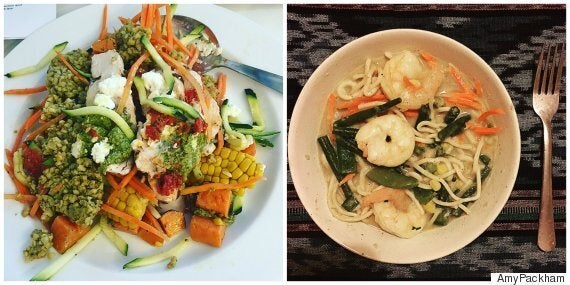
Pesto chicken, butternut squash and courgette grain salad (L), Thai prawn and peanut noodle bowl (R)
Coates advised that people should aim to consume one to two sources of dairy per day, red meat twice per week and oily fish two to four times per week.
He said we should ensure we are eating five to seven servings of fruit (two servings) and veg (five servings) per day."
I definitely didn't do this before the plan. Usually my dinner consisted of a carb (pasta, spaghetti, rice, cous cous), chicken or quorn, and vegetables (peppers, tomatoes, green beans). I rarely ate fish, dairy or red meat and I never varied my vegetables, let alone had enough servings.
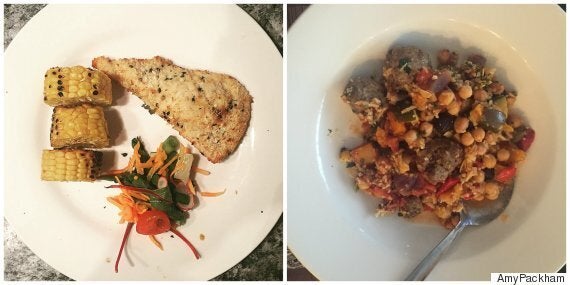
Lemon and sesame crusted chicken with coleslaw (L), Beef meatball tagine with cauliflower cous cous (R)
But in this plan, breakfast ranged from beetroot and raspberry yoghurt, to cheese and onion frittatas and porridge. Lunch was a mixture of cold salad and meats, homemade burgers, soup and pork and dinner include everything from beef to salmon, chicken and prawns.
It's possibly the most varied diet I have had in six days since I was a child.
At the end of the six days I was full of enthusiasm and going back to the usual stir fry, bagels and porridge just didn't cut it.
I genuinely felt bored at the food I was eating, yet I didn't have the money to carry it on (or the time to cook it all).
"Buy frozen vegetables instead of fresh, it saves time and usually they contain a higher amount of vitamins and minerals," Coates said.
"When making food from scratch make three times more, portion out into servings and freeze any you aren't going to eat, this way you have two healthy meals for later in the week without having to cooked from scratch again.
"Don't bother peeling vegetables or fruit e.g. carrots, potatoes and apples - just give them a good scrub to clean them, the skin contains most of the goodness in these ingredients, plus it saves you time!"
So I did it, I made a big batch of food for lunch which included the lessons I learned: food I'd never tried before, fruit with my meal, and variation (I never usually ate fish).
Yum.
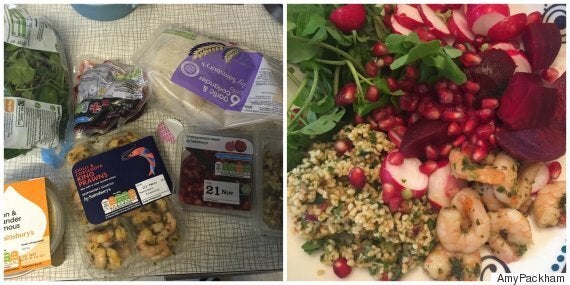
Putting my new and improved salad-making skills to the test
Can I afford £165 for this package on a regular basis?
Definitely not, but for me the plan was not only about the ease of getting ready-made food delivered to your door, but also a six-day lesson in new foods to eat, try, and cook myself.